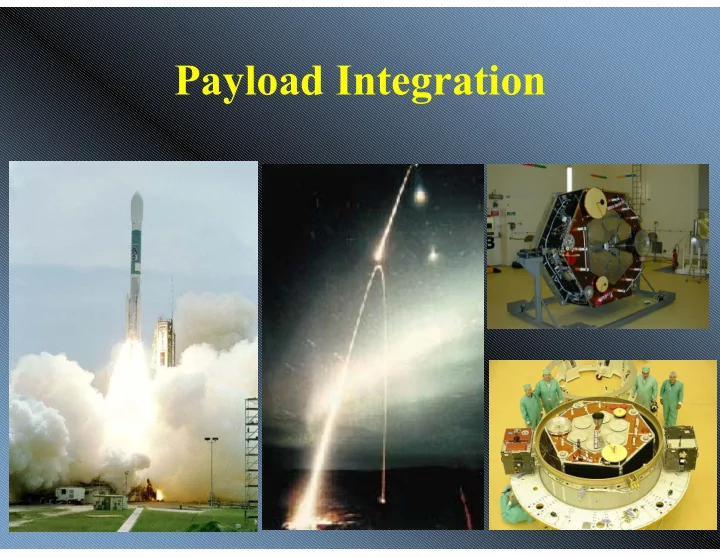

Payload Integration
What is a payload A payload can be anything from a small electronics box to a satellite. Payloads include satellites of all sizes, cameras, scientific instruments, communications equipment, sensors, and others. Payload adapter with three satellites Camera payload
What does a payload integrate into Clementine Satellite Sounding rocket Delta II Rocket NASA WB-57 High altitude airplane High altitude balloon
How do you integrate a payload? You need to know the design constraints. How heavy can the payload be? How big can the payload be? What shape can a payload be? What does the payload have to do? What kind of tests do you do on the payload? Vibration and shock Thermal and vacuum tests Spin balance Electromagnetic interference
Design Constraints How big and heavy can the payload be? It depends on the vehicle. Rockets can lift only so much weight. A rocket will not reach space if the payload is too heavy. The payload has to fit in the payload faring. Shape and size are important
Vibration Testing Payload is shaken to make sure it can survive launch. Shake tables simulate rocket vibration. Powerful speakers can simulate sound waves generated by rocket.
Thermal and Vacuum Tests Vacuum testing is used to see if the payload will work properly in space. Components behave differently when there is no air. Thermal testing in vacuum is used to see if the payload will survive and work in extreme temperatures. Exposure to the sun in space can heat up the payload to hundreds of degrees. When the payload is in the dark, it can get very cold.
Spin Balance The payload needs to be balanced so the rocket will fly straight. If satellite is to spin in space, it must be balanced so it won't wobble. The payload is placed on a platform that spins. Special sensors in the platform are used to indicate where weight has to be added to make the payload balanced. The big cylinder in the picture is used to cover the satellite during the spin balance so the air will not interfere. The air inside the cylinder will start to spin with the satellite.
Electromagnitic Interference Testing Electromagnetic interference testing or EMI testing is performed to make sure the payload does not generate radio signals at wrong frequencies and cause problems to other payloads, the rocket or satellite. It is also used to test if the payload is sensitive to any radio signals. This is done to make sure the payload can perform its mission. You can see many cones sticking out of the wall. Those cones are made of a special material designed to absorb radio signals. The facility is designed to stop all radio signals from interfering with the test. Only the signals generated during the test are seen in the facility. The cones also stop the radio signals from being bounced around.
Final Integration There are three satellites installed on the platform. The platform will be mounted on top of the rocket. Satellite is bolted to carrier. Notice the size of the payload faring.
Final Integration The rocket is being brought in for The payload platform is being mounted on payload integration. the rocket.The rocket is below the floor. Only the very top of the rocket comes through the floor.
Final Integration Another much larger satellite is installed on top of the smaller ones. This rocket will launch four satellites.
Integration complete, Launch! The rocket takes off at night. Rocket is rolled out to the launch pad.
Experiment #1 Mass experiment: Take a helium filled balloon with a string tied to it. Tie a loop in the string. Take a bunch of paper clips and hang them on the loop. Keep doing it until the balloon stops rising. Weigh the paper clips that are attached to the string. This is the weight limit that the balloon is able to lift. The paper clips you used can be considered as the payload and the balloon as the vehicle.
Experiment #2 Spin Balance Take a gyroscope and spin it up with a string. Observe that it stays on one tip as the gyroscope spins. Now, take a small piece of clay and insert tightly in the spoke of the gyroscope. Try spinning the gyroscope again. Observe its behavior. The gyroscope doesn't stay on its tip. It either wobbles around or falls over due to the wieght imbalance. This is what can happen in space when a spinning satellite is not properly balanced.
Recommend
More recommend